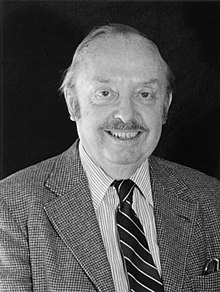Keith R. Porter
Keith Roberts Porter | |
|---|---|
 | |
| Born | June 11, 1912 Yarmouth,Nova Scotia,Canada |
| Died | May 2, 1997(aged 84) Bryn Mawr,Pennsylvania,U.S. |
| Nationality | Canadian, American |
| Occupation | Cell biologist |
Keith Roberts Porter(June 11, 1912 – May 2, 1997) was aCanadian-Americancell biologist.He created pioneering biology techniques and research usingelectron microscopyofcells.Porter also contributed to the development of other experimental methods forcell cultureandnuclear transplantation.He was also responsible for naming theendoplasmic reticulum,conducting work on the 9 + 2microtubulestructure in theaxonemeofcilia,and coining the term "microtrabecular lattice."In collaborations with other scientists, he contributed to the understanding of cellular structures and concepts such ascompartmentalization,flagella,centrioles,fibrin,collagen,T-tubulesandsarcoplasmic reticulum.He also introducedmicrotomecutting.
Early life and education[edit]
Keith Porter was born inYarmouth,Nova Scotia,on June 11, 1912, the son of Aaron and Josephine Roberts Porter. He finished his undergraduate program atAcadia Universityin 1934, and became a graduate student atHarvard University.[1]At Harvard, he earned a doctorate (Ph.D.) for his work on frog embryo development in 1938. Following this degree, he married Katherine Elizabeth Lingley, a former student at Acadia University. They had one son, Gregory, who died just over one year later.[2]Starting in the early 1940s, he conducted research atThe Rockefeller Institute for Medical Researchin New York. He eventually became a citizen of the United States in 1947.
Career/research[edit]
In 1939, Porter was a research assistant at The Rockefeller Institute for Medical Research under James B. Murphy, a cancer researcher. Porter focused his early work in Murphy's lab on the effect of carcinogens onembryonic developmentof rat embryos. Because it was difficult for them to fix these cells properly to the slide, Porter concluded thatosmium tetroxidepreserved the cells the best.[3]When Porter made aphotomicrographof the first cell, he noticed that only the thin sections could be seen. The nuclei region was a dark blob due to all the internal structures surrounding the nucleus. He needed a higher penetration power to see the thicker portions of the cell. Only small sections of thinly sliced cells were able to be micro-graphed, so Porter turned his attention to developing a way that whole cells could be photographed.[3]In conjunction with Joseph Blum, he designed anultramicrotomesection of specific tissue thickness to allow the electron microscope to penetrate these cells.[3]By 1956, he became a professor and full member at theRockefeller University.
From 1961 to 1967, Porter returned to Harvard University and was chair of thebiologydepartment (1965–1967). Porter's research at Harvard concerned the sarcoplasmic reticulum and T system; he conducted this work in collaboration withClara Franzini-Amstrong.He then explored the role of microtubules inmotility,cell division,and control of cell shape withLewis Tilney,J. Richard McIntosh,and Ursula Goodenough-Johnson.[4]
In 1968, Porter left to work as chair of the new Department ofMolecular,Cellular,andDevelopmental Biologyat theUniversity of Colorado Boulder.Porter spearheaded a laboratory dedicated to a higher voltage (1000 kV)electron microscopethat improved the ability to examine the interior of cells by virtue of its high penetrating power.[5]When he retired, at age 70, the university awarded him an honorary degree and renamed "his" building Porter Biosciences.
Porter became a professor at theUniversity of Maryland, Baltimore County(UMBC) in 1984 before joining Lee D. Peachey’s laboratory at theUniversity of Pennsylvaniain 1988, post-retirement. UMBC's Keith R. Porter Core Imaging Facility is dedicated to Porter.
Porter helped found theAmerican Society for Cell Biologyand the Journal of Cell Biology. The Keith R. Porter Endowment for Cell Biology, founded in 1981, supports an annualKeith R. Porter Lectureat the conference ofAmerican Society for Cell Biology.
Recognition[edit]
In 1970, together withAlbert ClaudeandGeorge E. Palade,Porter was awarded theLouisa Gross Horwitz PrizefromColumbia University.Porter's colleaguesAlbert Claude,Christian de DuveandGeorge E. Paladewere awarded a Nobel Prize in 1974 "for describing the structure and function of organelles in biological cells", work that Porter is also well known for.[6]Although Porter is known by many as "The Father of Cell Biology," he never officially won aNobel Prizefor his achievements and contributions to science.
Awards and honors[edit]
- 1957 elected to theAmerican Academy of Arts and Sciences[7]
- 1964Gairdner Foundation International Award
- 1964 elected to the United StatesNational Academy of Sciences[8]
- 1970Louisa Gross Horwitz PrizeofColumbia University
- 1971Dickson Prize in Science
- 1971Paul Ehrlich and Ludwig Darmstaedter Prize
- 1976National Medal of Science
- 1977 elected to theAmerican Philosophical Society[9]
- 1981E. B. Wilson Medal
References[edit]
- ^Schliwa, M. (1997). Keith roberts porter (1912-97).Nature, 387(6635), 764.
- ^Peachey, L. D. (2006). Keith roberts porter.Proceedings of the American Philosophical Society, 150(4), 685.
- ^abcSatir, P. (1997). Keith R. porter and the first electron micrograph of a cell.Endeavour, 21(4), 169-171.
- ^Peachey, L. D. (2013). Keith R. porter.National Academy of Sciences,1-21.
- ^Palade, G. E. (1977). Keith Roberts Porter and the development of contemporary cell biology.The Journal of Cell Biology, 75(1), D1.
- ^Westly, Erica (October 6, 2008)."No Nobel for You: Top 10 Nobel Snubs".Scientific American.
- ^"Keith Roberts Porter".American Academy of Arts & Sciences.Retrieved2022-07-19.
- ^"Keith R. Porter".nasonline.org.Retrieved2022-07-19.
- ^"APS Member History".search.amphilsoc.org.Retrieved2022-07-19.
- Moberg CL (March 1995)."The electron microscope enters the realm of the intact cell".J. Exp. Med.181(3): 831–7.doi:10.1084/jem.181.3.831.PMC2191944.PMID7869045.
- Moberg CL (1996). "Keith Porter and the Founding of the Tissue Culture Association".In Vitro Cell Dev Biol Anim.32(10): 663–9.doi:10.1007/BF02724051.S2CID12844113.
- Satir P (July 1997)."Keith Roberts Porter: 1912–1997".J. Cell Biol.138(2): 223–4.doi:10.1083/jcb.138.2.223.PMC2138189.PMID9273349.
- Keith Porter biography and images,Image & Video LibraryofThe American Society for Cell Biology
External links[edit]
- The Official Site of Louisa Gross Horwitz Prize
- Keith R. Porter Papers (1938–1993)at the University of Colorado at Boulder
- Keith Porter papers, 1950-1987at theUniversity of Maryland, Baltimore County
- American biologists
- 1912 births
- 1997 deaths
- People from Yarmouth, Nova Scotia
- Scientists from Nova Scotia
- Harvard University alumni
- Acadia University alumni
- National Medal of Science laureates
- 20th-century biologists
- Cell biologists
- Canadian scientists
- Canadian emigrants to the United States
- Members of the American Philosophical Society
